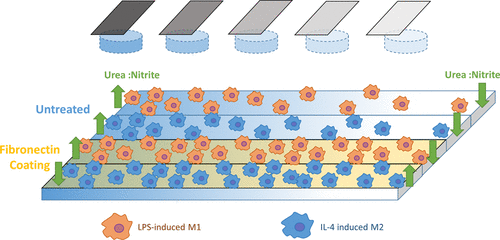当前位置:
X-MOL 学术
›
ACS Appl. Bio Mater.
›
论文详情
Our official English website, www.x-mol.net, welcomes your feedback! (Note: you will need to create a separate account there.)
Macrophage Phenotypic Changes on FN-Coated Physical Gradient Hydrogels
ACS Applied Bio Materials ( IF 4.7 ) Pub Date : 2021-08-25 , DOI: 10.1021/acsabm.1c00489 Zhuqing Li 1 , Kaitlin M Bratlie 1, 2
ACS Applied Bio Materials ( IF 4.7 ) Pub Date : 2021-08-25 , DOI: 10.1021/acsabm.1c00489 Zhuqing Li 1 , Kaitlin M Bratlie 1, 2
Affiliation

|
The chemical and physical properties are two crucial cues when designing tissue engineering scaffold to mimic living tissue. Macrophages, the major players in the immune response, react rapidly to microenvironmental signals, including gradients of physical or chemical cues. Spatiotemporal gradients can modulate cell behavior, such as polarization, proliferation, and adhesion. Here, we studied macrophage phenotypic changes on untreated and fibronectin (FN)-coated methacrylated gellan gum with varying stiffnesses. The compressive moduli of hydrogel with different stiffnesses ranged from ∼5 to 30 kPa. Fibronectin was chemically attached to the substrate to facilitate macrophage proliferation, adhesion, and polarization. Classically (M1) and alternatively (M2) activated macrophages were cultured on both untreated and FN-coated gels. FN-coated substrates elevated cell numbers and enhanced macrophage spreading. The urea/nitrite ratio indicated that untreated rigid substrates shifted both polarizations toward a more proinflammatory phenotype. FN-coated substrates had no impact on M1 polarization. In contrast, FN-coated stiffer gels polarized M2 cells toward an anti-proinflammatory state based on arginine activity and CD206 expression. In addition, macrophage polarization on the softer gel was not influenced by the neighboring cells cultured on the stiffer side of the gel. Using mechanical gradients to control macrophage polarization can be a useful tool in ensuring a proper healing response and for tissue engineering.
中文翻译:

FN 涂层物理梯度水凝胶的巨噬细胞表型变化
在设计组织工程支架以模拟活组织时,化学和物理特性是两个关键线索。巨噬细胞是免疫反应的主要参与者,对微环境信号(包括物理或化学信号的梯度)反应迅速。时空梯度可以调节细胞行为,例如极化、增殖和粘附。在这里,我们研究了具有不同刚度的未经处理和纤连蛋白 (FN) 涂层的甲基丙烯酸酯结冷胶上的巨噬细胞表型变化。具有不同刚度的水凝胶的压缩模量范围为~5至30 kPa。纤连蛋白以化学方式附着在基质上以促进巨噬细胞增殖、粘附和极化。经典 (M1) 或 (M2) 活化的巨噬细胞在未经处理和 FN 包被的凝胶上培养。FN 包被的底物增加了细胞数量并增强了巨噬细胞的扩散。尿素/亚硝酸盐比率表明,未经处理的刚性底物将两种极化都向更促炎的表型转变。FN 涂层基板对 M1 极化没有影响。相比之下,基于精氨酸活性和 CD206 表达的 FN 涂层较硬的凝胶将 M2 细胞极化为抗炎状态。此外,较软凝胶上的巨噬细胞极化不受在凝胶较硬一侧培养的相邻细胞的影响。使用机械梯度来控制巨噬细胞极化可能是确保适当的愈合反应和组织工程的有用工具。尿素/亚硝酸盐比率表明,未经处理的刚性底物将两种极化都向更促炎的表型转变。FN 涂层基板对 M1 极化没有影响。相比之下,基于精氨酸活性和 CD206 表达的 FN 涂层较硬的凝胶将 M2 细胞极化为抗炎状态。此外,较软凝胶上的巨噬细胞极化不受在凝胶较硬一侧培养的相邻细胞的影响。使用机械梯度来控制巨噬细胞极化可能是确保适当的愈合反应和组织工程的有用工具。尿素/亚硝酸盐比率表明,未经处理的刚性底物将两种极化都向更促炎的表型转变。FN 涂层基板对 M1 极化没有影响。相比之下,基于精氨酸活性和 CD206 表达的 FN 涂层较硬的凝胶将 M2 细胞极化为抗炎状态。此外,较软凝胶上的巨噬细胞极化不受在凝胶较硬一侧培养的相邻细胞的影响。使用机械梯度来控制巨噬细胞极化可能是确保适当的愈合反应和组织工程的有用工具。较软凝胶上的巨噬细胞极化不受在凝胶较硬一侧培养的相邻细胞的影响。使用机械梯度来控制巨噬细胞极化可能是确保适当的愈合反应和组织工程的有用工具。较软凝胶上的巨噬细胞极化不受在凝胶较硬一侧培养的相邻细胞的影响。使用机械梯度来控制巨噬细胞极化可能是确保适当的愈合反应和组织工程的有用工具。
更新日期:2021-09-20
中文翻译:

FN 涂层物理梯度水凝胶的巨噬细胞表型变化
在设计组织工程支架以模拟活组织时,化学和物理特性是两个关键线索。巨噬细胞是免疫反应的主要参与者,对微环境信号(包括物理或化学信号的梯度)反应迅速。时空梯度可以调节细胞行为,例如极化、增殖和粘附。在这里,我们研究了具有不同刚度的未经处理和纤连蛋白 (FN) 涂层的甲基丙烯酸酯结冷胶上的巨噬细胞表型变化。具有不同刚度的水凝胶的压缩模量范围为~5至30 kPa。纤连蛋白以化学方式附着在基质上以促进巨噬细胞增殖、粘附和极化。经典 (M1) 或 (M2) 活化的巨噬细胞在未经处理和 FN 包被的凝胶上培养。FN 包被的底物增加了细胞数量并增强了巨噬细胞的扩散。尿素/亚硝酸盐比率表明,未经处理的刚性底物将两种极化都向更促炎的表型转变。FN 涂层基板对 M1 极化没有影响。相比之下,基于精氨酸活性和 CD206 表达的 FN 涂层较硬的凝胶将 M2 细胞极化为抗炎状态。此外,较软凝胶上的巨噬细胞极化不受在凝胶较硬一侧培养的相邻细胞的影响。使用机械梯度来控制巨噬细胞极化可能是确保适当的愈合反应和组织工程的有用工具。尿素/亚硝酸盐比率表明,未经处理的刚性底物将两种极化都向更促炎的表型转变。FN 涂层基板对 M1 极化没有影响。相比之下,基于精氨酸活性和 CD206 表达的 FN 涂层较硬的凝胶将 M2 细胞极化为抗炎状态。此外,较软凝胶上的巨噬细胞极化不受在凝胶较硬一侧培养的相邻细胞的影响。使用机械梯度来控制巨噬细胞极化可能是确保适当的愈合反应和组织工程的有用工具。尿素/亚硝酸盐比率表明,未经处理的刚性底物将两种极化都向更促炎的表型转变。FN 涂层基板对 M1 极化没有影响。相比之下,基于精氨酸活性和 CD206 表达的 FN 涂层较硬的凝胶将 M2 细胞极化为抗炎状态。此外,较软凝胶上的巨噬细胞极化不受在凝胶较硬一侧培养的相邻细胞的影响。使用机械梯度来控制巨噬细胞极化可能是确保适当的愈合反应和组织工程的有用工具。较软凝胶上的巨噬细胞极化不受在凝胶较硬一侧培养的相邻细胞的影响。使用机械梯度来控制巨噬细胞极化可能是确保适当的愈合反应和组织工程的有用工具。较软凝胶上的巨噬细胞极化不受在凝胶较硬一侧培养的相邻细胞的影响。使用机械梯度来控制巨噬细胞极化可能是确保适当的愈合反应和组织工程的有用工具。


























 京公网安备 11010802027423号
京公网安备 11010802027423号